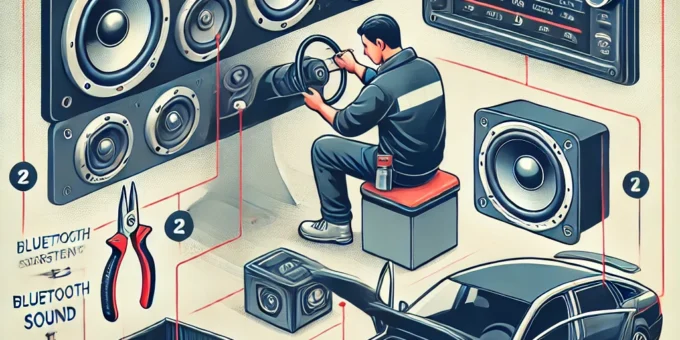
A great car audio system can turn every drive into an immersive experience. Whether you’re commuting to work or embarking on a road trip, crisp highs, deep bass, and clear sound can make your journey more enjoyable. If your current car audio system lacks the punch or clarity you desire, it might be time for an upgrade.
This guide will walk you through everything you need to know about upgrading your car’s audio system, including selecting the right components, installation tips, and maximizing sound quality for your investment.
Signs You Need to Upgrade Your Audio System
Here are some common signs that your car audio system might need an upgrade:
- Muffled or Flat Sound: Factory speakers often lack depth and clarity.
- Distorted Bass or Treble: Your speakers crackle or distort at higher volumes.
- Lack of Modern Features: Your system doesn’t support Bluetooth, Apple CarPlay, or Android Auto.
- No Subwoofer: The bass lacks punch, especially in music genres like hip-hop or electronic.
- Road Noise Overpowers Music: You struggle to hear your music clearly while driving.
Understanding the Basics of Car Audio Systems
Before upgrading, it’s important to understand the key components of a car audio system:
- Head Unit (Stereo): Controls the audio system and serves as the interface for playback and settings.
- Speakers: Convert electrical signals into sound. Includes tweeters (high frequencies), midrange, and woofers (low frequencies).
- Amplifier: Boosts the audio signal to power the speakers for louder and clearer sound.
- Subwoofer: Enhances low-frequency sounds for deep, rich bass.
- Wiring and Connectors: Transmit audio signals between components.
Tip: Upgrading one component often improves the overall sound quality, but for the best experience, consider a full system upgrade.
Step 1: Upgrade Your Car’s Speakers
Factory-installed speakers are often made with low-quality materials, leading to subpar sound.
Why Upgrade Your Speakers?
- Better clarity and detail in music.
- Improved durability with materials like polypropylene, Kevlar, or silk.
- Enhanced frequency response for a balanced sound.
Types of Aftermarket Speakers:
- Coaxial Speakers: Combine tweeters and woofers into one unit. Easy to install and great for beginners.
- Component Speakers: Separate tweeters, woofers, and crossovers for superior sound quality.
Tip: Choose speakers that match your car’s size and power requirements.
Step 2: Add an Amplifier for More Power
An amplifier boosts your audio signal, providing more power to your speakers and improving sound clarity.
Benefits of Adding an Amplifier:
- Eliminates distortion at higher volumes.
- Enhances the dynamic range, making music more vibrant.
- Powers subwoofers and high-performance speakers effectively.
How to Choose an Amplifier:
- Match the amplifier’s RMS power rating to your speakers’ power handling.
- Consider a 4-channel amp for speakers or a mono amp for subwoofers.
Step 3: Install a Subwoofer for Deep Bass
Subwoofers are essential for reproducing low-frequency sounds, adding depth and richness to your music.
Benefits of a Subwoofer:
- Reduces strain on your other speakers by handling bass frequencies.
- Improves overall sound quality and balance.
Types of Subwoofers:
- Powered Subwoofers: Combine a subwoofer and amplifier into one unit for easy installation.
- Passive Subwoofers: Require an external amplifier for power but offer more customization.
Tip: Place the subwoofer in the trunk or under the seat, depending on your car’s layout.
Step 4: Replace Your Head Unit
Upgrading your head unit can transform your car’s audio system by adding modern features and better sound processing.
Features to Look For:
- Bluetooth for hands-free calling and music streaming.
- Apple CarPlay and Android Auto compatibility.
- Touchscreen displays for intuitive control.
- Built-in equalizers and sound processing features.
Tip: Ensure the new head unit fits your car’s dash or purchase a compatible installation kit.
Step 5: Use Sound-Deadening Materials
Road noise can interfere with your music. Adding soundproofing materials helps reduce this problem.
Benefits of Sound Deadening:
- Reduces vibrations and noise from the road and engine.
- Improves sound clarity by isolating audio from external noise.
Popular Soundproofing Materials:
- Dynamat
- Noico Sound Deadening Mats
- Soundproofing sprays
Where to Apply: Doors, floorboards, trunk, and roof.
Step 6: Optimize Your System with Equalizers
An equalizer (EQ) lets you fine-tune your system’s sound balance.
Benefits of an EQ:
- Adjusts frequencies to suit your music preferences.
- Corrects issues like overly harsh treble or muddy bass.
Tip: Start with a flat EQ setting, then make small adjustments based on your preferences.
DIY vs. Professional Installation
DIY Installation:
- Cost-effective for those with technical skills.
- Requires tools like wire strippers, crimpers, and a multimeter.
Professional Installation:
- Ensures proper wiring and compatibility.
- Saves time and reduces the risk of damaging your car’s electrical system.
Tip: If you’re installing a full system upgrade, professional installation is often worth the cost.
Budget-Friendly Upgrades for Better Sound
If you’re on a budget, consider these affordable upgrades:
- Replace factory speakers with entry-level aftermarket models.
- Add a small powered subwoofer under the seat.
- Use a sound-deadening mat on the doors to improve clarity.
Common Mistakes to Avoid When Upgrading Audio
- Skipping Research: Ensure all components are compatible with your car and each other.
- Ignoring Power Ratings: Match the power handling of your speakers and amp.
- Cheap Wiring: Low-quality cables can introduce noise and reduce performance.